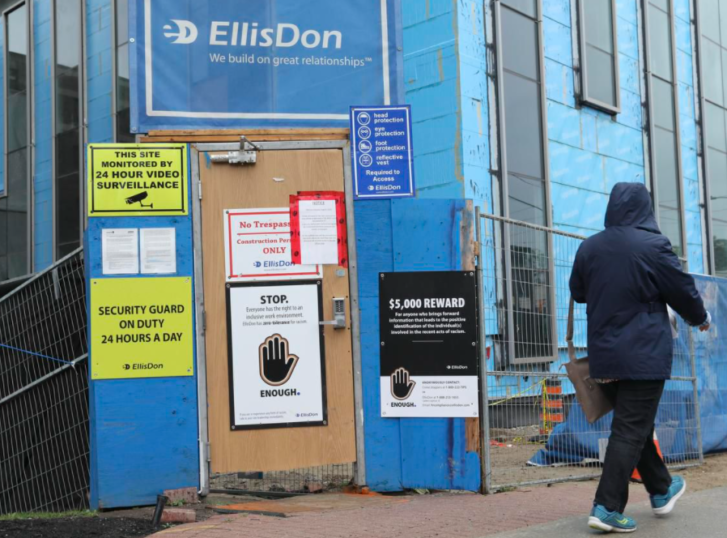As Ontario enters the third month of its fourth pandemic wave, case counts continue to be stubbornly high despite growing vaccination levels and widespread restrictions on businesses.
Provincial public heath data indicates a key factor could be the lack of widespread vaccination requirements for workers at warehouses, manufacturers and construction sites, the workplaces where the majority of COVID-19 transmission is now taking place.
Data from Ontario’s Ministry of Health shows that outside of the education system, such workplaces continue to be the leading source of active outbreaks in the province. But a survey of employers in those sectors by the Star shows that many are still not requiring that workers get vaccinated to enter work sites.
Health experts say that could be a sign that more needs to be done to boost vaccination efforts in the manufacturing and construction sectors.

“It’s not surprising that lots of workers all under one roof for an extended period, some unvaccinated, would create conditions where COVID-19 spreads,” said Colin Furness, an epidemiologist at the University of Toronto.
As of Tuesday, the ministry was reporting 48 active outbreaks among “other workplaces” — which include manufacturers, warehouses, construction sites and offices — compared to 15 active outbreaks among bars, restaurants, gyms, tattoo shops and hair salons.
Meanwhile, Toronto Public Health has reported that 51 per cent of all workplace outbreaks have come from a warehouse, manufacturer, food processor or construction site in the city, since it began publishing workplace COVID-19 data. That figure vastly eclipses the number of outbreaks at restaurants, bars and gyms, which comprise 12 per cent of the city’s total.
While restaurants, bars and gyms have vaccine certificate requirements to help protect customers and keep COVID-19 off the premises, larger manufacturers and construction sites have relatively few provincially mandated requirements to curb COVID-19 spread.
Peel Region, home to the bulk of warehouses and manufacturers in the province, introduced measures last April to temporarily close workplaces that reported three or more COVID-19 cases among staff. Those measures were revoked in June, however, in advance of Ontario’s first stage of reopening.
Most major employers introduced mask mandates and social-distancing guidelines for workers early on in the pandemic, but few have imposed company-wide vaccine requirements for managers and employees.
The Star contacted more than a dozen manufacturers, food processors and construction sites that have faced workplace outbreaks in the past to find out how many now require workers to be vaccinated to access work sites.
Amazon, EllisDon, Amherst Crane Rental, WG Pro-Manufacturing, Pioneer Steel Buildings and National Energy Equipment all said that they do not require staff to be vaccinated, despite having reported workplace outbreaks at their Ontario locations in the past.
Two companies — Ya Ya Foods and Reliance Construction — said they do require staff to be vaccinated. The other companies contacted did not respond by deadline.
EllisDon, one of Canada’s largest construction companies, said it aims to have all employees vaccinated by November, while Amherst Crane Rental said it hopes to implement a mandatory vaccine policy by the end of October.
Raywat Deonandan, an epidemiologist at the University of Ottawa, says employers may not be mandating vaccines for workers in these sectors to maintain staffing levels.
“They’re probably afraid of the human resources repercussions,” said Deonandan. “Unfortunately, vaccine hesitancy can be very high in these groups and they run the risk of really alienating and disenfranchising a number of workers, and that could potentially affect productivity.”
The Canadian Federation of Independent Business, which supports vaccine-certificate requirements for small businesses, has pointed to the comparatively lax rules for larger corporations as one of the reasons why many sole proprietors feel like the province’s rules have disproportionately hurt small business.
“This is what we’ve seen throughout the pandemic, and it’s been a major source of frustration among small business owners,” said Ryan Mallough, Ontario regional director of the CFIB.
“They’re wondering: why do we have these extra administrative burdens and responsibilities when we’re not the spaces that are leading workplace outbreaks?”
Deena Ladd, executive director of the Workers’ Action Centre, said part of the problem is attributable to meagre benefits and few paid sick days for workers in these sectors.
Ontario introduced a temporary sick-day program in April, after long-standing pressure from advocates and health experts who said that access to fully paid sick days was crucial to containing the virus. The program lets employers claim up to $200 per day of leave, for up to three days.
While the program led to a surge in sick-day claims from workers, Ladd said the overall number of claims is “minuscule.”
“We found that the workers who used those paid sick days didn’t use them because they got sick but rather they used them to get vaccinated,” Ladd said.
“Many workers are still fearful of telling their employer they’re taking the day off because they’re sick, maybe with COVID-19. Many still go to work even if they’re sick.”
Article From: The Star
Author: Jacob Lorinc

